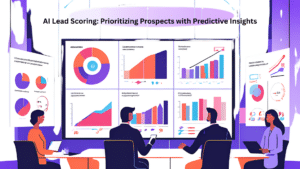In the ever-changing realm of sales and marketing, knowing your leads is crucial to successfully transforming prospects into loyal customers. Predictive lead scoring is an innovative approach that uses Artificial Intelligence (AI) and machine learning to improve the quality of leads and effectively manage prospective clients. This article focuses on exploring the features of predictive lead scoring, how it operates and can be configured, and how significantly it impacts lead management and conversion rates.
What is Predictive Lead Scoring and How Does It Work?
Understanding Predictive Lead Scoring
Predictive lead scoring is a data-centric technique that applies sophisticated algorithms to analyze historical data and behavioral patterns to assess prospective leads and rank them according to their likelihood of becoming customers. As opposed to traditional lead scoring, which is dependent primarily on demographic information and shallow engagement metrics, predictive lead scoring is built on deep analytics. With this technique, marketers and sales teams can pinpoint new leads whose characteristics closely replicate those of previously converted customers.

How Predictive Lead Scoring Uses Machine Learning
The foundation of predictive lead scoring is based on machine learning, the artificial intelligence subfield that allows systems to improve their predictions by learning from previous data. These systems utilize predictive modeling techniques to scan large amounts of data in order to find the main attributes and actions associated with successful conversions. Therefore, as the system receives more data, it improves the accuracy of the predictive lead scoring model. This enhanced accuracy significantly benefits the sales and marketing teams, who rely on insights rather than raw data for their decisions.
Differences Between Traditional Lead Scoring and Predictive Lead Scoring
While traditional lead scoring focuses on static criteria like job titles, company size, and engagement level of a lead, it often offers a fundamental overview of an account’s lead score. Hence, this provides a simplistic view of lead scoring and, worse still, fails to consider vital elements such as the probability of predicting successful leads to notice and bridge gaps. Predictive lead scoring, on the other hand, focuses on an extraordinarily broad set of factors that include behavioral data, previous interactions with the company, and even outside market movements. This comprehensive approach empowers salespersons to focus on leads already inclined to convert, boosting conversion rates for highly productive accounts and streamlining the entire lead scoring system.
How to Configure Predictive Lead Scoring for Your CRM?
Steps to Set Up Predictive Lead Scoring in HubSpot
Setting up predictive lead scoring in HubSpot involves several steps to ensure that the scoring model aligns with your specific business needs. First, you must define your ideal customer profile based on historical data and marketing automation insights. Next, integrate relevant data sources into HubSpot to create a comprehensive view of your leads. Then, utilize HubSpot’s lead scoring tool to build a predictive model by selecting the key attributes that indicate a lead’s likelihood to convert. Finally, continuously monitor the performance of the scoring system to refine and optimize the model over time.
Integrating Predictive Lead Scoring with Salesforce
Salesforce users can also enhance their lead management strategies by integrating predictive lead scoring into their CRM. To do this, begin by identifying the essential data points that will feed into your scoring model, such as previous interactions and demographic information. Utilize Salesforce’s robust reporting capabilities to analyze past conversions and identify patterns. After establishing your predictive lead scoring model, it’s crucial to train your sales team on how to interpret lead scores effectively, ensuring they understand how to prioritize leads based on these insights. This integration will streamline the sales pipeline, providing salespersons with a clear direction on which leads to focus their efforts.
Common Challenges in Configuring Lead Scoring Models
While configuring predictive lead scoring models can significantly enhance lead quality, several challenges may arise during the process. One common issue is the potential for human error when inputting data, which can skew the scoring results and lead to misprioritized leads. Additionally, ensuring that your scoring system remains dynamic and adjusts to changing market conditions can be difficult. Regularly updating the lead scoring model based on new data and feedback from the sales team is essential for maintaining accuracy and effectiveness in predicting lead conversion rates.
How Can Predictive Lead Scoring Improve Lead Quality?
Identifying Quality Leads with AI Lead-Scoring Solutions
Predictive lead scoring leverages AI lead-scoring solutions to identify and rank high-quality leads effectively. By analyzing an array of data points, from behavioral interactions with marketing materials to demographic characteristics, these solutions can pinpoint which leads are most likely to convert. This intelligent analysis allows marketers and sales teams to focus their efforts on leads that are not just interested but are also the right fit for their products or services, ultimately leading to higher conversion rates and improved lead qualification rates.
How to Prioritize Leads Based on Lead Scores
Once lead scores have been assigned, prioritizing leads becomes a more systematic process. High-scoring leads should be flagged for immediate follow-up by the sales team, while lower-scoring leads can be nurtured through targeted marketing campaigns. By effectively categorizing leads based on their scores, salespersons can allocate their time and resources more efficiently, ensuring that they are engaging with prospects that have a higher probability of conversion. This targeted approach minimizes wasted efforts and maximizes the chances of closing deals.
Measuring the Impact of Predictive Lead Scoring on Conversion Rates
To evaluate the effectiveness of your predictive lead scoring model, it is crucial to measure its impact on conversion rates systematically. By comparing the conversion rates of leads who were prioritized based on predictive scoring against those who were not, you can gain insights into the model’s success. Additionally, tracking metrics such as lead qualification rates and the average time to conversion will provide further clarity on how predictive lead scoring enhances overall sales performance. Continuous analysis of these metrics will enable marketing and sales teams to refine their strategies and achieve even better results over time.
What Are the Key Components of a Lead Scoring Model?
Important Factors in Building a Lead Scoring Algorithm
Creating a robust lead scoring algorithm necessitates a deep understanding of what influences lead conversion. Important factors include engagement level, demographic information, and historical purchase behavior. Weight each component according to its relevance to your business objectives. For instance, assign a higher score to leads who have previously interacted with your marketing campaigns than to those who haven’t. Moreover, integrating feedback from the sales team can also enhance the algorithm, ensuring it reflects real-world experiences and outcomes.
Using Demographic and Behavioral Data in Your Scoring Models
Employing both demographic and behavioral data in your scoring models is essential for achieving accurate and actionable insights. Demographic data provides a foundational understanding of who your leads are, while behavioral data sheds light on how they engage with your brand. By combining these two types of data, you can create a well-rounded scoring model that accounts for both the characteristics of the leads and their interactions within the sales pipeline. This dual approach ensures that your predictive lead scoring reflects the complexities of customer behavior, leading to better prioritization of leads.
Customizing Scoring Models for Different Types of Leads
Not all leads are created equal, which is why customizing your scoring models for different types of leads is crucial. For instance, leads generated through inbound marketing efforts may require a different scoring approach compared to those acquired through cold outreach. By understanding the unique traits of each lead type, you can tailor your scoring models to reflect these differences, ensuring that your predictive lead scoring system is both flexible and effective. This level of customization enables your sales and marketing teams to develop targeted strategies that resonate with different segments of your audience.
How to Train Your Sales Team to Use Predictive Lead Scoring Effectively?
Educating the Sales Team on Lead Scores and Their Importance
Training your sales team on the significance of lead scores is vital for the successful implementation of predictive lead scoring. Educate them on how lead scoring works and how to leverage it to prioritize prospects more effectively. This education should encompass the methodology behind scoring, the types of data considered, and the implications of lead scores on their daily activities. When salespersons understand the rationale behind lead scores, they are more likely to embrace and utilize the insights provided to enhance their sales efforts.
Best Practices for Using Predictive Lead Scoring in the Sales Pipeline
Implementing best practices for utilizing predictive lead scoring within the sales pipeline can significantly boost its effectiveness. Sales teams should regularly review and discuss lead scores during team meetings, ensuring that everyone is aligned on which leads to prioritize. Additionally, integrating lead scoring insights into daily workflows, such as CRM updates and lead follow-ups, will create a seamless process for managing leads. Furthermore, encouraging open communication between sales and marketing teams will foster collaboration, allowing for a more cohesive approach to leveraging lead scoring insights.
Monitoring and Adjusting the Scoring Process for Continuous Improvement
Lastly, tracking and fine-tuning the scoring methodology is crucial for predictive lead scoring refinement. Salespersons focus on leads already inclined to convert, boosting conversion rates for highly productive accounts and streamlining the entire lead scoring system. Periodic assessment of performance benchmarks for the AI lead scoring model in relation to real-world conversion figures will Determine trends and provide intervention to the algorithm where necessary. Through ongoing evaluation and improvement, organizations can ensure their AI lead scoring adapts to changes that affect sales outcomes.
Conclusion
The use of AI in predicting lead scoring optimizes managing leads by pinpointing promising constituents using data patterns. By adopting this new model, sales teams can devote their time to leads that are most likely to convert, improving operational efficiency and increasing conversion rates. In today’s ever-changing market, ensuring predictive lead scoring will enhance your sales approach while optimizing organizational performance.



